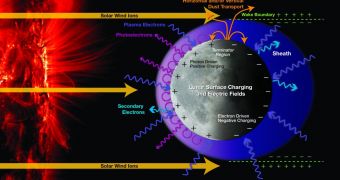NASA plans to send a manned mission to the Moon by 2020, but in order to do that it must once again learn what the Moon is like. "Humans will return to the Moon in a few years and have to know what to expect. How do you live and work in a place filled with moondust? We're trying to find out," said James Spann from the University of Alabama.
Good question. Imagine the amazement of the Apollo 11 crew when they saw themselves surrounded by nothing but dry electrically charged lunar dust, crawling and creeping through all the cracks and edges of the spacesuits and equipment, clogging joints, blackening surfaces and so on. "The troublesome clinginess had a lot to do with moondust's electrostatic charge," explains Spann.
Unlike the Earth that is protected from the action of the solar wind by a powerful magnetic field, the Moon is directly exposed to the radiation emitted from the Sun. Charged particles such as electrons interact with the lunar dust, electrically charging it in the process. By replicating the same conditions experienced on the lunar surface at the "Dusty Plasma Lab" in Alabama, NASA engineers were able to learn how the moondust behaves during daylight on the Moon.
Mian Abbas, also from the University of Alabama and participant in the study, reveals that during the experiment lunar dust grains were bombarded with electrons generated by an electron gun, while suspended in a vacuum chamber. "We've had some surprising results. We're finding that individual dust grains do not act the same as larger amounts of moon dust put together. Existing theories based on calculations of the charge of a large amount of moondust don't apply to the moondust at the single particle level," said Abbas.
Moondust grains behave very strangely while individually subjected to electric charge. In one attempt during the experiment, Abbas used a grain of moondust charged positively. However, when bombarded with electrons, the grain built up an even higher positive charge, opposed to the general belief that a negative charge should be built. One explanation would be that the collision between the dust grain and the electrons must have ejected other electrons from the atoms, thus increasing the positive charge.
The way a lunar dust grain behaves under the action of solar wind is mostly dependent on the size, charge and the number of colliding electrons. "We believe the single grains will behave differently on the moon, too - not just in our lab. Our results are closer to what's really happening on the moon. We're saying, 'Hey wait a second guys. We're finding something odd. When you go to the moon, it's going to a little different than you thought," concluded Spann.

 14 DAY TRIAL //
14 DAY TRIAL //